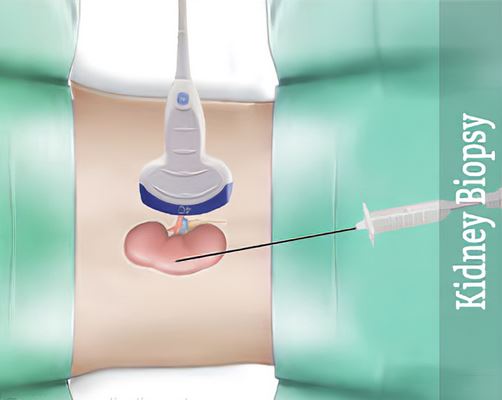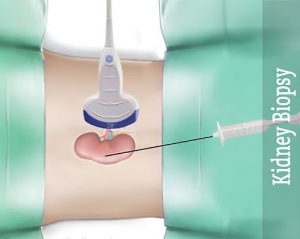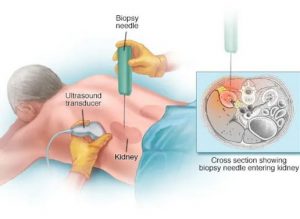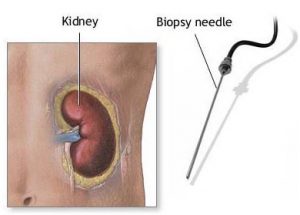
Kidney Renal Biopsy Needle in Nigeria by Scantrik Medical Supplies
We are Nigeria’s No.1 Dealer, Wholesaler, Distributor and Supplier Store of Kidney Renal Biopsy Needle with Best Price
Kidney Renal Biopsy Needle
Kidney biopsy is also called renal biopsy is a procedure during which a small piece of kidney tissue is removed and examined under microscope with a variety of stains to identify the underlying disease which is affecting the kidney function. The procedure of kidney biopsy is generally safe and can provide valuable information regarding the underlying kidney disease and helps in treatment.
KIDNEY RENAL BIOPSY NEEDLE SET
Consists of five parts, including a thin wall needle with special beveled tip which is sharpened around the edge.Sharp pointed trocar is used for initial skin pierce. Special shaped Biopsy stop (curved pin) eliminates loss in handling and prevents damage to specimen should the biopsy be drawn into the cannula or into the syringe.Fitted obturator is used for securing biopsy stop in position and to clean the cannula. Adjustable needle stop provides controlled depth penetration for maximum safety.
What Happens During A Kidney Biopsy Procedure
A kidney biopsy may be done on an outpatient basis or in a hospital. It may be done in a procedure room, in a hospital bed, or in the radiology department. Procedures may vary depending on your condition and your healthcare provider’s practices.
Generally, a kidney needle biopsy follows this process:
· You will remove your clothing and put on a hospital gown.
· An intravenous (IV) line may be started in your arm or hand.
· You will lie on your stomach so that the doctor can easily reach the kidney. A pillow may be used to hold you in the right position. If you have a transplanted kidney, you will lie on your back.
· The skin over the biopsy site will be cleaned with an antiseptic solution.
· You will feel a needle stick when the local anesthetic is injected. This may cause a brief stinging sensation.
· You will need to lie still during the procedure.
· Ultrasound or X-ray may be used to guide the needle into the kidney.
· You will be asked to breathe in and hold your breath while the doctor inserts the biopsy needle into the kidney. This prevents movement of the diaphragm, which may interfere with the placement of the biopsy needle.
· You may feel discomfort or pressure when the healthcare provider takes the sample.
· There may be more than one puncture if the healthcare provider needs more than one tissue sample. If so, the same puncture process will be repeated.
· When the needle is withdrawn, firm pressure will be applied to the biopsy site to stop bleeding.
· A sterile bandage or dressing will be applied.
· The kidney tissue sample will be sent to the lab for testing.
· Talk with your healthcare provider about what you will have during your kidney biopsy.
What Happens After The Kidney Biopsy
Your recovery will vary depending on the type of procedure done and your healthcare provider’s practices. You may be taken to the recovery room and watched closely as the anesthesia wears off. Once your blood pressure, pulse, and breathing are stable and you are alert, you may be taken to a hospital room or discharged to your home.
You will be asked to lie on your back for several hours. A nurse will check your urine for signs of bleeding. You may have blood tests to check for internal bleeding. You may be discharged later the same day or the next day. If you had a sedative or anesthetic, plan to have someone drive you home.
The biopsy site may be tender or sore for several days after the biopsy. Take a pain reliever for soreness as advised by your healthcare team. You may need to avoid aspirin or certain other pain medications that may raise the chance of bleeding. Be sure to take only recommended medications.
Tell your healthcare team to report any of the following:
· Blood in your urine after the first 24 hours
· Inability to urinate
· Fever and/or chills
· Redness, swelling, or bleeding or other drainage from the biopsy site
· Increased pain around the biopsy site or elsewhere
· Feeling faint
You may get back to your usual diet unless told otherwise. Your healthcare team may ask you to rest for a day or two. You will need to avoid strenuous physical activity for several days. Do not do any type of “bouncing” activities, such as jogging, aerobics, playing tennis, or horseback riding for a couple of weeks to prevent bleeding of the biopsy site.
Your healthcare provider may give you other instructions after the procedure, depending on your situation.




